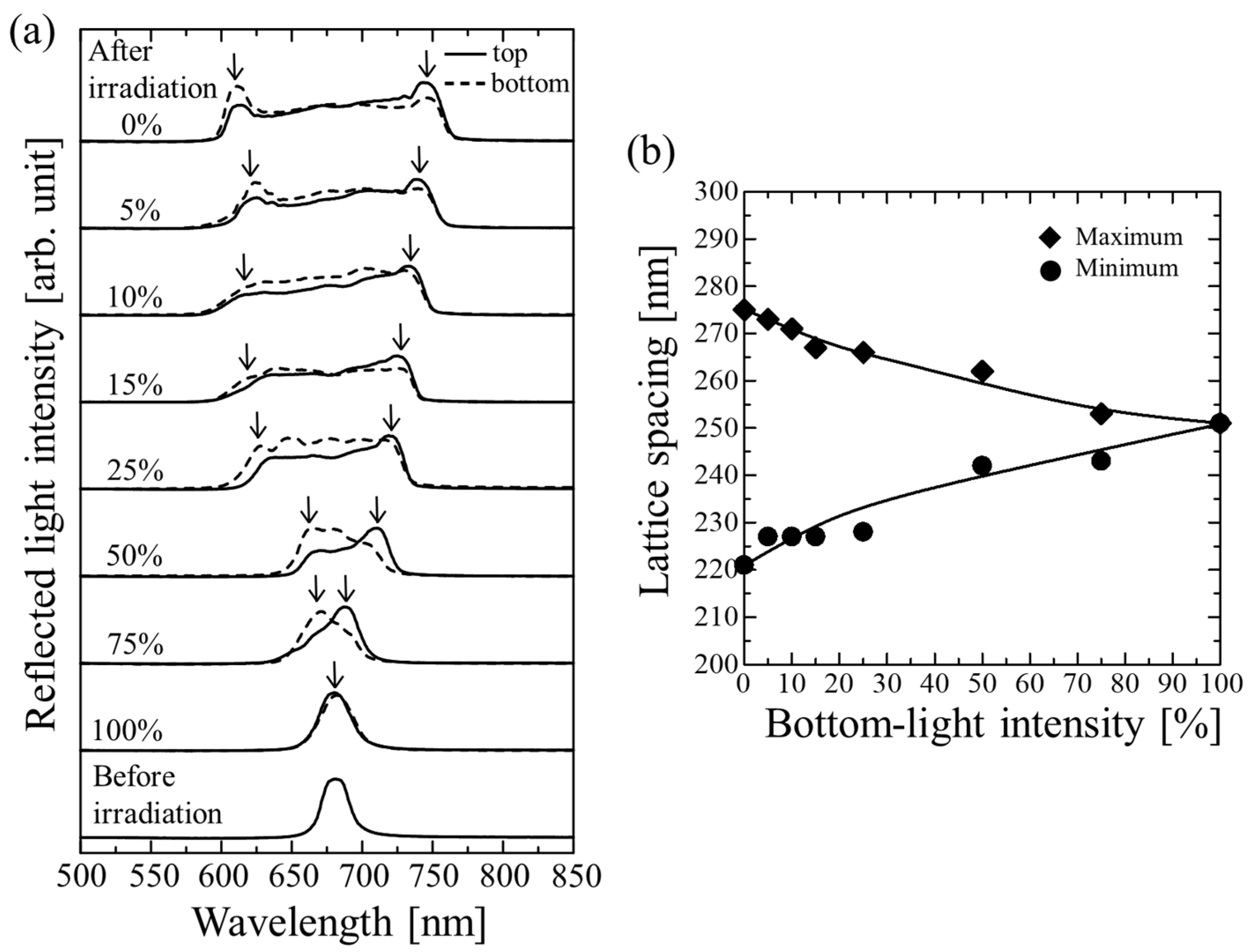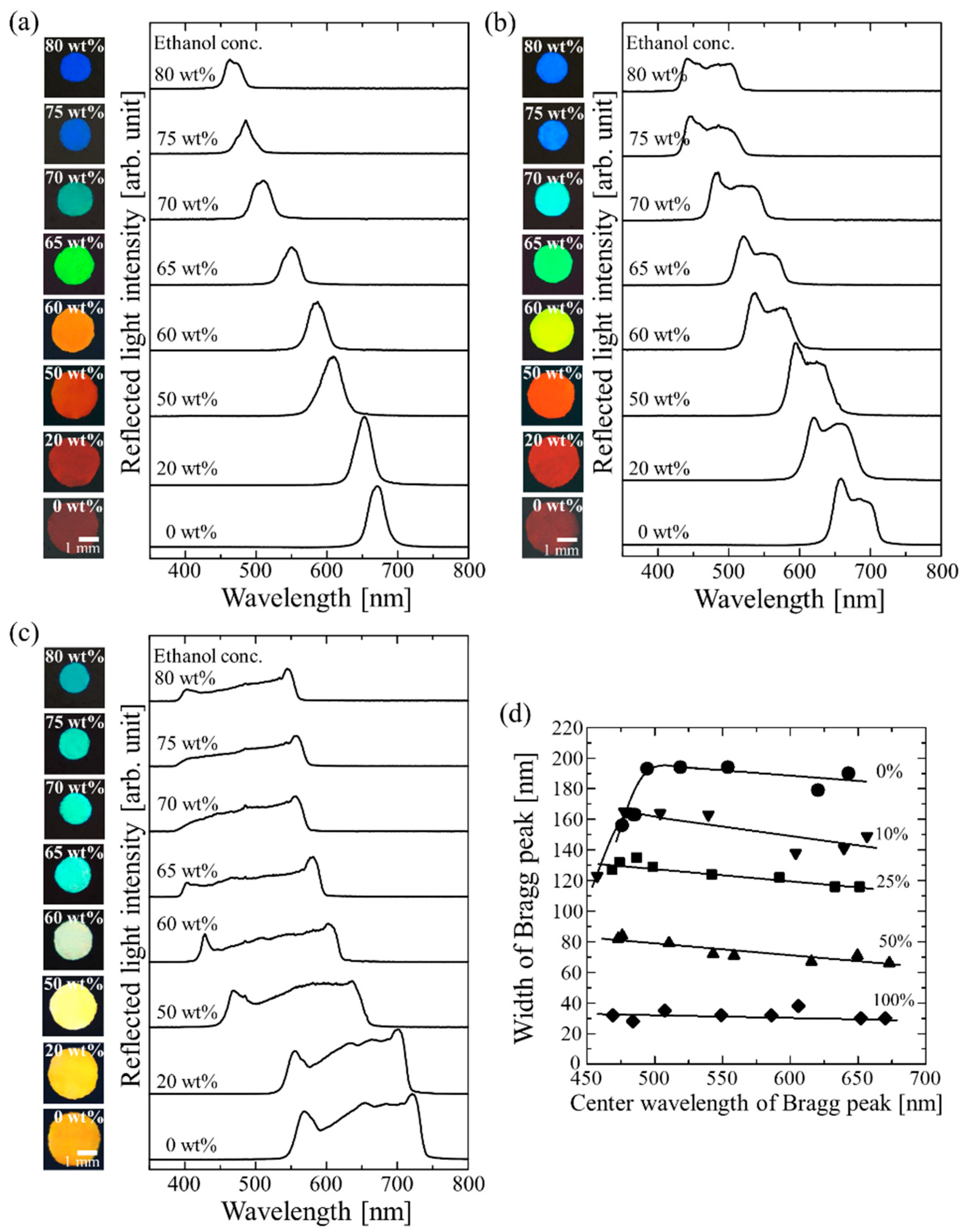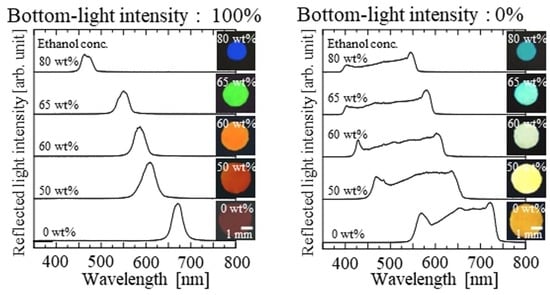Tuning of Optical Stopband Wavelength and Effective Bandwidth of Gel-Immobilized Colloidal Photonic Crystal Films
Abstract
1. Introduction
2. Results and Discussion
3. Conclusions
4. Materials and Methods
Author Contributions
Funding
Institutional Review Board Statement
Informed Consent Statement
Data Availability Statement
Acknowledgments
Conflicts of Interest
References
- Pieranski, P. Colloidal Crystals. Contemp. Phys. 1983, 24, 25–73. [Google Scholar] [CrossRef]
- Xia, Y.; Gates, B.; Yin, Y.; Lu, Y. Monodispersed Colloidal Spheres: Old Materials with New Applications. Adv. Mater. 2000, 12, 693–713. [Google Scholar] [CrossRef]
- Yoshino, K.; Kawagishi, Y.; Ozaki, M.; Kose, A. Mechanical Tuning of the Optical Properties of Plastic Opal as a Photonic Crystal. Jpn. J. Appl. Phys. 1999, 38, L786–L788. [Google Scholar] [CrossRef]
- Baba, T. Slow Light in Photonic Crystals. Nat. Photonics 2008, 2, 465–473. [Google Scholar] [CrossRef]
- Hou, J.; Li, M.; Song, Y. Patterned Colloidal Photonic Crystals. Angew. Chem. Int. Ed. 2018, 57, 2544–2553. [Google Scholar] [CrossRef]
- Clough, J.M.; Weder, C.; Schrettl, S. Mechanochromism in Structurally Colored Polymeric Materials. Macromol. Rapid Commun. 2021, 42, 2000528. [Google Scholar] [CrossRef] [PubMed]
- Lee, G.H.; Han, S.H.; Kim, J.B.; Kim, D.J.; Lee, S.; Hamonangan, W.M.; Lee, J.M.; Kim, S. Elastic Photonic Microbeads as Building Blocks for Mechanochromic Materials. ACS Appl. Polym. Mater. 2020, 2, 706–714. [Google Scholar] [CrossRef]
- Lin, S.Y.; Fleming, J.G.; Hetherington, D.L.; Smith, B.K.; Biswas, R.; Ho, K.M.; Sigalas, M.M.; Zubrzycki, W.; Kurtz, S.R.; Bur, J. A Three-Dimensional Photonic Crystal Operating at Infrared Wavelengths. Nature 1998, 394, 251–253. [Google Scholar] [CrossRef]
- Noda, S.; Tomoda, K.; Yamamoto, N.; Chutinan, A. Full Three-Dimensional Photonic Bandgap Crystals at Near-Infrared Wavelengths. Science 2000, 289, 604–606. [Google Scholar] [CrossRef]
- Furumi, S.; Fudouzi, H.; Miyazaki, H.T.; Sakka, Y. Flexible Polymer Colloidal-Crystal Lasers with a Light-Emitting Planar Defect. Adv. Mater. 2007, 19, 2067–2072. [Google Scholar] [CrossRef]
- Kim, S.H.; Kim, S.H.; Jeong, W.C.; Yang, S.M. Low-Threshold Lasing in 3D Dye-Doped Photonic Crystals Derived from Colloidal Self-Assemblies. Chem. Mater. 2009, 21, 4993–4999. [Google Scholar] [CrossRef]
- Weissman, J.M.; Sunkara, H.B.; Tse, A.S.; Asher, S.A. Thermally Switchable Periodicities and Diffraction from Mesoscopically Ordered Materials. Science 1996, 274, 959–963. [Google Scholar] [CrossRef] [PubMed]
- Holtz, J.H.; Holtz, J.S.W.; Munro, C.H.; Asher, S.A. Intelligent Polymerized Crystalline Colloidal Arrays: Novel Chemical Sensor Materials. Anal. Chem. 1998, 70, 780–791. [Google Scholar] [CrossRef]
- Kanai, T.; Yano, H.; Kobayashi, N.; Sawada, T. Enhancement of Thermosensitivity of Gel-Immobilized Tunable Colloidal Photonic Crystals with Anisotropic Contraction. ACS Macro Lett. 2017, 6, 1196–1200. [Google Scholar] [CrossRef]
- Katsura, C.; Nobukawa, S.; Sugimoto, H.; Nakanishi, E.; Inomata, K. Solvent-Responsive Coloring Behavior of Colloidal Crystal Films Consisting of Cross-Linked Polymer Nanoparticles. Colloid Polym. Sci. 2017, 295, 1709–1715. [Google Scholar] [CrossRef]
- Foulger, S.H.; Jiang, P.; Lattam, A.C.; Smith, D.W.; Ballato, J. Mechanochromic Response of Poly(ethylene glycol) Methacrylate Hydrogel Encapsulated Crystalline Colloidal Arrays. Langmuir 2001, 17, 6023–6029. [Google Scholar] [CrossRef]
- Fenzl, C.; Wilhelm, S.; Hirsch, T.; Wolfbeis, O.S. Optical Sensing of the Ionic Strength Using Photonic Crystals in a Hydrogel Matrix. ACS. Appl. Mater. Interface 2013, 5, 173–178. [Google Scholar] [CrossRef]
- Tajima, H.; Amano, A.; Kanai, T. Elastomer-Immobilized Tunable Colloidal Photonic Crystal Films with High Optical Qualities and High Maximum Strain. Mater. Adv. 2021, 2, 3294–3299. [Google Scholar] [CrossRef]
- Miwa, E.; Watanabe, K.; Asai, F.; Seki, T.; Urayama, K.; Odent, J.; Raquez, J.M.; Takeoka, Y. Composite Elastomer Exhibiting a Stress-Dependent Color Change and High Toughness Prepared by Self-Assembly of Silica Particles in a Polymer Network. ACS Appl. Polym. Mater. 2020, 2, 4078–4089. [Google Scholar] [CrossRef]
- Kubo, S.; Gu, Z.Z.; Takahashi, K.; Fujishima, A.; Segawa, H.; Sato, O. Tunable Photonic Band Gap Crystals Based on a Liquid Crystal-Infiltrated Inverse Opal Structure. J. Am. Chem. Soc. 2004, 126, 8314–8319. [Google Scholar] [CrossRef]
- Wang, H.; Liu, Y.; Chen, Z.; Sun, L.; Zhao, Y. Anisotropic Structural Color Particles from Colloidal Phase Separation. Sci. Adv. 2020, 6, 1438. [Google Scholar] [CrossRef]
- Arsenault, A.C.; Puzzo, D.P.; Manners, I.; Ozin, G.A. Photonic-Crystal Full-Colour Displays. Nat. Photonics 2007, 1, 468–472. [Google Scholar] [CrossRef]
- Han, M.G.; Heo, C.J.; Shin, C.G.; Shim, H.S.; Kim, J.W.; Jin, Y.W.; Lee, S.Y. Electrically Tunable Photonic Crystals from Long-Range Ordered Crystalline Arrays Composed of Copolymer Colloids. J. Mater. Chem. C 2013, 1, 5791–5798. [Google Scholar] [CrossRef]
- Holtz, J.H.; Asher, S.A. Polymerized Colloidal Crystal Hydrogel Films as Intelligent Chemical Sensing Materials. Nature 1997, 389, 829–832. [Google Scholar] [CrossRef] [PubMed]
- Furumi, S.; Kanai, T.; Sawada, T. Widely Tunable Lasing in a Colloidal Crystal Gel Film Permanently Stabilized by an Ionic Liquid. Adv. Mater. 2011, 23, 3815–3820. [Google Scholar] [CrossRef]
- Iwayama, Y.; Yamanaka, J.; Takiguchi, Y.; Takasaka, M.; Ito, K.; Shinohara, T.; Sawada, T.; Yonese, M. Optically Tunable Gelled Photonic Crystal Covering Almost the Entire Visible Light Wavelength Region. Langmuir 2003, 19, 977–980. [Google Scholar] [CrossRef]
- Kanai, T.; Sawada, T.; Yamanaka, J.; Kitamura, K. Critical Concentration for Colloidal Crystallization Determined with Microliter Centrifuged Suspensions. Langmuir 2005, 21, 7633–7637. [Google Scholar] [CrossRef]
- Ryan, C.C.; Delezuk, J.A.M.; Pavinatto, A.; Oliveira , O.N., Jr.; Fudouzi, H.; Pemble, M.E.; Bardosova, M. Silica-Based Photonic Crystals Embedded in a Chitosan-TEOS Matrix: Preparation, Properties and Proposed Applications. J. Mater. Sci. 2016, 51, 5388–5396. [Google Scholar] [CrossRef]
- Jiang, P.; Ostojic, G.N.; Narat, R.; Mittleman, D.M.; Colvin, V.L. The Fabrication and Bandgap Engineering of Photonic Multilayers. Adv. Mater 2001, 13, 389–393. [Google Scholar] [CrossRef]
- Park, J.H.; Choi, W.S.; Koo, H.Y.; Hong, J.C.; Kim, D.Y. Doped Colloidal Photonic Crystal Structure with Refractive Index Chirping to the [111] Crystallographic Axis. Langmuir 2006, 22, 94–100. [Google Scholar] [CrossRef]
- Kanai, T.; Sawada, T.; Toyotama, A.; Yamanaka, J.; Kitamura, K. Tuning the Effective Width of the Optical Stop Band in Colloidal Photonic Crystals. Langmuir 2007, 23, 3503–3505. [Google Scholar] [CrossRef]
- Saito, H.; Takeoka, Y.; Watanabe, M. Simple and Precision Design of Porous Gel as a Visible Indicator for Ionic Species and Concentration. Chem. Commun. 2003, 3, 2126–2127. [Google Scholar] [CrossRef] [PubMed]
- Pagonis, K.; Bokias, G. Temperature- and Solvent-Sensitive Hydrogels Based on N-isopropylacrylamide and N,N-dimethylacrylamide. Polym. Bull. 2007, 58, 289–294. [Google Scholar] [CrossRef]
- Lee, K.; Asher, S.A. Photonic Crystal Chemical Sensors: pH and Ionic Strength. J. Am. Chem. Soc. 2000, 122, 9534–9537. [Google Scholar] [CrossRef]
- Sakiyama, T.; Takata, H.; Toga, T.; Nakanishi, K. pH-Sensitive Shrinking of a Dextran Sulfate/Chitosan Complex Gel and Its Promotion Effect on the Release of Polymeric Substances. J. Appl. Polym. Sci. 2001, 81, 667–674. [Google Scholar] [CrossRef]
- Toyotama, A.; Kanai, T.; Sawada, T.; Yamanaka, J.; Ito, K.; Kitamura, K. Gelation of Colloidal Crystals without Degradation in Their Transmission Quality and Chemical Tuning. Langmuir 2005, 21, 10268–10270. [Google Scholar] [CrossRef] [PubMed]
- Zhang, Y.; Wang, Y.; Wang, H.; Yu, Y.; Zhong, Q.; Zhao, Y. Super-Elastic Magnetic Structural Color Hydrogels. Small 2019, 15, 1902198. [Google Scholar] [CrossRef]
- Kanai, T.; Sawada, T.; Kitamura, K. Optical Determination of the Lattice Constants of Colloidal Crystals without Use of the Refractive Index. Langmuir 2003, 19, 1984–1986. [Google Scholar] [CrossRef]
- Zhang, X.; Wang, X.; Li, L.; Wu, R.; Zhang, S.; Wu, J.; Wu, W. A Novel Polyacrylamide-Based Superabsorbent with Temperature Switch for Steam Breakthrough Blockage. J. Appl. Polym. Sci. 2015, 132, 42067. [Google Scholar] [CrossRef]
- Călina, I.; Demeter, M.; Scărișoreanu, A.; Micutz, M. Development of Novel Superabsorbent Hybrid Hydrogels by E-Beam Crosslinking. Gels 2021, 7, 189. [Google Scholar] [CrossRef]




Disclaimer/Publisher’s Note: The statements, opinions and data contained in all publications are solely those of the individual author(s) and contributor(s) and not of MDPI and/or the editor(s). MDPI and/or the editor(s) disclaim responsibility for any injury to people or property resulting from any ideas, methods, instructions or products referred to in the content. |
© 2023 by the authors. Licensee MDPI, Basel, Switzerland. This article is an open access article distributed under the terms and conditions of the Creative Commons Attribution (CC BY) license (https://creativecommons.org/licenses/by/4.0/).
Share and Cite
Amano, A.; Kanai, T. Tuning of Optical Stopband Wavelength and Effective Bandwidth of Gel-Immobilized Colloidal Photonic Crystal Films. Gels 2023, 9, 56. https://doi.org/10.3390/gels9010056
Amano A, Kanai T. Tuning of Optical Stopband Wavelength and Effective Bandwidth of Gel-Immobilized Colloidal Photonic Crystal Films. Gels. 2023; 9(1):56. https://doi.org/10.3390/gels9010056
Chicago/Turabian StyleAmano, Ami, and Toshimitsu Kanai. 2023. "Tuning of Optical Stopband Wavelength and Effective Bandwidth of Gel-Immobilized Colloidal Photonic Crystal Films" Gels 9, no. 1: 56. https://doi.org/10.3390/gels9010056
APA StyleAmano, A., & Kanai, T. (2023). Tuning of Optical Stopband Wavelength and Effective Bandwidth of Gel-Immobilized Colloidal Photonic Crystal Films. Gels, 9(1), 56. https://doi.org/10.3390/gels9010056







